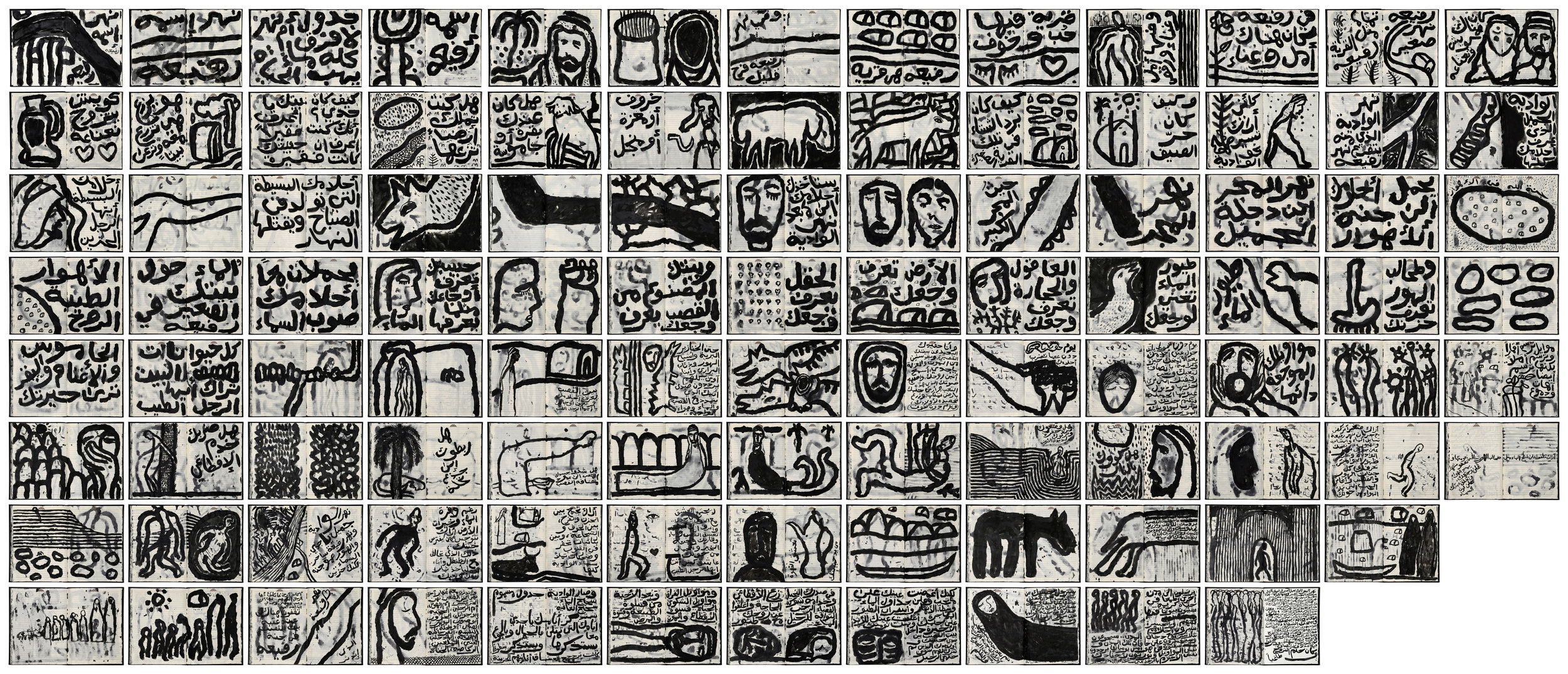Sadik Kwaish Alfraji: The River That Was in the South
Sadik Alfraji. Weeping of the South, 2019. Image courtesy of Ayyam Gallery
There is a melancholy that hangs in the air amid The River That Was in the South, Sadik Kwaish Alfraji’s current exhibition at Ayyam Gallery. Followers of the artist’s work will be familiar with this lament because it populates most of his oeuvre. Through the elongated and often weeping figures that appear in his drawings and his poignant animations which are accompanied by haunting soundtracks, viewers of Alfraji’s work are left hanging somewhere between nostalgia and sorrow—a space infused with a poetic romanticism that is compelling.
The River That Was in the South, begins with a poem of the same name that describes part of Alfraji’s personal history. He writes about his grandfather’s generation, who lived suspended between the idyllic surroundings of the marshlands of southern Iraq and the toll of existing under a feudalist system. Then, he describes their migration: “The paths of migration glisten like gold painting a bright horizon”; but later, those paths become “burdened with misery and loss”.
This poem is presented as the exhibition statement on the opening wall of the show and then repeated in Alfraji’s own hand in Arabic along the facing wall, where the text takes the form of a horizontal ribbon guiding the viewers eyeline into the gallery—also calling to mind the shape of the river, the exhibition’s protagonist. “I am not a poet,” counters Alfraji, when I ask him to tell me about his written words. “Rather, when I start a new project, the poems inside me wake up and join me on the journey. The words help me a lot to delve deeper into the specific project on which I am working.”
Sadik Kwaish Alfraji: Rivers Book 1 (2018). Image courtesy of Ayyam Gallery.
The River That Was in the South tells the real story of Alfraji’s ancestors who lived on the Tigris-Euphrates marshlands in harmony with the environment, wholly from the natural resources. They were displaced during the 1980s and 1990s, when Saddam Hussein drained the marshes and their journey of migration began. Alfraji himself was born in Baghdad, where his family ended up, but he continued to migrate and now resides in the Netherlands.
Themes of nostalgia, war, death, and despair emerge throughout this exhibition with perhaps one of the most moving works of the show coming in the form of Weeping of the South – a monumental 5.5 metre canvas depicting a sea of faces gathered together upon a background of wave-like forms with long, black tears streaming from their eyes. The motion in the painting and the intensity of the expressions makes the viewer feel as if they are witnessing a shipwreck or a disaster happening in real time. It is the artist’s innate ability to convey tragedy that gives rise to this feeling. Indeed, this painting carries with it the heart of the show.
The animated film that plays in the room adjacent to this massive charcoal and ink work also narrates the story to which we are privy. Whilst the iron jaws of dictatorship eat up the marshlands, the plight of the people is brought to the fore as the soul-stirring film draws to a close.
In Rivers Book 1 and 2 – a continuous thread of prints on paper revealing themselves in a diary-style - we see small doodles peppered with fragments of Arabic text. Again, they are personal, and offer a window into Alfraji’s creative journey. “The birds know your pain, the trees know your pain, the land knows your pain,” reads Alfraji as we walk in front of the works and then he begins to muse, “we are some kind of floating tragedy and when we view ourselves, we face the fragility of our existence.”
Still from the animation The River That Was in the South by Sadik Kwaish Alfraji. Image courtesy of Ayyam Gallery.
It is with these thoughts that I round back on myself to stand in front of another wall of much larger drawings spelling out the words of Salman Al Mankoub, a poet from the region of Southern Iraq that this show pays homage to. The drawings take the form of an installation bracketed by two speakers emitting the spoken words of Al Mankoub, and though they are alien to my ears, the words again capture the essence of nostalgia embedded into the fabric of the show.
Despite the despair present at almost every turn, there is a kernel of hope to raise the spirits. In a 55-minute video, the viewer is placed upon one of the marshland boats and upon the river itself. Whilst Alfraji says the river of his grandfather’s memory – which he himself has never seen – no longer exists, for this piece, he travelled back to the marshlands and made this video that depicts nothing but the front of a small boat as it weaves through the wetlands. In 2003, the marshes were listed as a UNESCO Heritage Site and they are beginning to regain their former glory. “Always, there is hope,” he says. “Without hope, there is no life.”
Sadik Kwaish Alfraji: The River That Was in the South. March 12 - April 25, 2019. Ayyam Gallery, Alserkal Avenue, Dubai.



